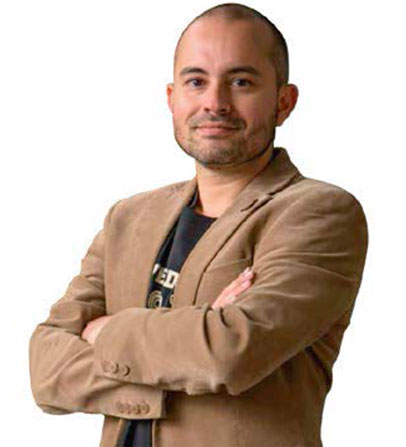Health students learn to work in inter-professional teams with an innovative methodology
By: Tania Valbuena
Photos:
Science and Tech

By: Tania Valbuena
Photos:
They were all first-year students from the School of Medicine and Health Sciences of Universidad del Rosario. Some were preparing to graduate in Speech Therapy, others in Medicine, and others still in Occupational Therapy, Physiotherapy, Psychology, or Biomedical Engineering. In total, there were 250, who, in groups of 10, had to attend to an important clinical case on the basis of their knowledge. It was about a 17-year-old college girl, pregnant, who had problems in not only her physical health (such as emesis or recurring vomiting, loss of appetite, and onset of hearing problems) but also her mental health (she went through social conflicts). When her parents found out about her pregnancy, her mother supported her, but her father did not. A tough situation for her.
For six weeks, students analyzed the implications and solutions of this hypothetical case, which could well have been a fact of real life. The objective of the professors was not to evaluate the disciplinary results, but show them how teamwork is carried out and to understand the identity of the different health related professions. Thus, in the future, everyone will be able to do integrated work, and not with each one contemplating their subject in isolation, as is often the case.
“With the project The inter-professional education mediated by ICTs at the beginning of health studies, we try to put together an instructional design team with experts from different health areas and to choose facilitators that have professions other than those of the students. A biomedical engineer was probably the tutor of a group of Medicine, Physiotherapy, Speech therapy, etc. students” explains Dr. John Vergel, MD., Ph.D., from the School of Medicine and Health Sciences of Universidad del Rosario and member of the team that decided to perform a pilot test with these students.
They started from the premise that training health professionals under a collaborative or teamwork model Educación Interprofesional, EIP (Inter-professional Education), mediated by Information and Communication Technologies (ICT), represents a great benefit for patients in care and with regard to security issues. This way, for a month and a half, they took students to immerse themselves in a virtual and practical learning environment designed particularly for them, from the e-Modules of Educación Interprofesional en Salud, Meip (Health Inter-professional Education), which were developed in levels, each with a pedagogical purpose.
“With this, we hope that when students arrive at hospitals to do their internships or practice their profession, they have different competences in relation to those who have not done inter-professional education. They have a high ability to work in a team and know and recognize the identity of the other professionals, decreasing tribalism, which is one of the problems of health care in hospitals and health centers,” says professor Vergel.
He and several members of the team acknowledge that they had not ventured into inter-professional education in every sense of the word, and precisely that helped them create a pedagogical strategy for students, who could even learn about other professions. “It was not clear to me, for example, who was a biomedical engineer, what they did although, every week, I had meetings with biomedical engineers, and now I know,” confesses Vergel.
For her part, Physiotherapist Sandra Liliana Forero highlights that those who were involved in this grew as professionals and educators. “We advance in the discourse in building a pedagogical methodology, which not only implies the case but also how we interact together to do quality work at the service of patients,” she points out.
Another of the fundamental objectives of this disruptive pedagogical model was understanding learning experiences from the tutors’ perspectives. Therefore, at the end of six weeks of work, a feedback process came with researchers (curriculum designers and 12 virtual tutors of the different professions of
the school), who were facilitators of the students’ tasks on the
Virtual Learning platform Moodle..
For Speech Therapist Rocío Molina, who has been part of the team since its creation, it has been fundamental to be able to implement the theory, working in class on all subjects, and acquiring a learning of their own. “Because when speaking of the inter-professional team, sometimes we do not even know very well the functions of each among ourselves. But more than the functions, the important thing is how to determine the quality of life together, how to provide solutions, how to share knowledge, and how to be part of a collaborative model.”
Occupational Therapist Karen Aguía Rojas agrees on this, and she describes this opportunity as “a deep learning, from case design to virtual tool management.” She also considers that it has allowed them to change their perspective regarding case resolution to one that is more critically analytical, by having different professionals interact. Precisely, in this analysis, the vision of a nursing professional could not be left out. Given that Universidad del Rosario seeks to open the Nursing Program, in the research study, there is Ángela Fernanda Espinosa, who is a professor of the Medicine Program, and who is interested in this initiative. For her, the experience was an opportunity to learn about the other disciplines and an exercise to recognize her own.
When we get a bit lost in building a case, we return to two fundamental points: One, the cases become more like a means. They are not the end. Two, it needs to be recognized that sometimes egos emerge when we face a discussion of a disciplinary order. We come back to the center, the patient, the subject of care, or the user,” she points out.

Doctor Pablo A. Bermúdez agrees with this assessment, for whom interdisciplinarity aims precisely to recognize health professionals as a group that works depending on the patient, which implies changing the tradition of putting doctors on top of a pyramidal organization. “They don't always have to be the leaders, or simply, the pyramid model is not the alternative,” he assures.